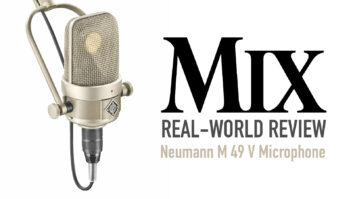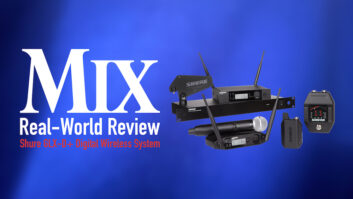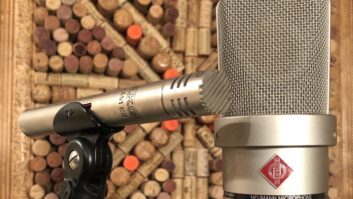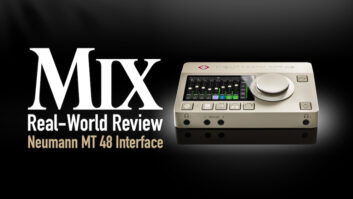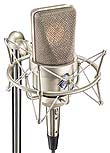
The TLM 103 D offers onboard digital conversion and software control over gain and parameters.
With the introduction of the TLM 103 back in 1997, Neumann created something of an instant classic that gave the project studio owner access to Neumann quality for a very reasonable price. The latest addition to the company’s line of Solution-D digital microphones is the TLM 103 D. As the name implies, this is a “digital version” of the original TLM 103.
Setup and Controls
The TLM 103 D’s preamplification, A/D conversion and DSP are handled onboard, and the output conforms to the recently established AES-42 standard for digital microphones. The requisite voltage for the mic is derived from Neumann’s DMI-2, which can power and control two Solution-D mics via standard XLR3 cables. The TLM 103 D can also connect directly to an AES/EBU or S/PDIF interface using a Neumann Connection Kit, though this precludes remote adjustment of mic parameters.
The DMI-2’s rear panel has two AES-42 mic inputs, two XLR AES outs, a 9-pin D-Sub connector, word clock I/O, power inlet and two RJ-45 Control Bus ports. Neumann thoughtfully includes an adapter that interfaces a standard USB cable with the RJ-45 Control Bus, facilitating data exchange between the DMI-2 and your computer. This conversion from USB format allows cable runs up to 100 meters.
The DMI-2 offers no external controls, so all gain, low cut, polarity, compression, phantom on/off and pattern switching are done using the included Remote Control Software (RCS). Any changes made via software are stored in the microphone negating the need for software once the mic is set up.
Stunning Realism
I used the TLM 103 D in a variety of situations with Digidesign and MOTU interfaces, and Digital Performer and Pro Tools software. External clock was usually derived from a Lucid GENx6-96 clock generator, though occasionally the audio interface was slaved to the DMI-2’s internal clock. The DMI-2 played nicely with all of my other gear at sample rates ranging from 44.1 to 176.4 kHz; 196kHz use requires dual-wire AES. I never experienced any sync issues and never heard any digital artifacts.
As expected, the TLM 103 D shares the assets of its analog namesake: the K 103 capsule, high-SPL handling (up to 138 dB) and extremely low self-noise. In A/B comparisons with the analog TLM 103 through a Grace 201 mic preamp, it was difficult — if not impossible — to tell the two apart. The only time that I could clearly hear a difference was when recording extremely quiet sources. Here, raising the control room monitors to ridiculously high gain, the TLM 103 track exhibited a bit of hiss, probably coming from the Grace 201 (which is no slouch in the S/N department), while the TLM 103 D lowered the noise floor to inaudibility. The TLM 103 D’s tone was well-balanced and present, with excellent transient response and “you are there” immediacy. As a room mic for a live drum kit, the TLM 103 D delivered a very realistic presentation of the kit with plenty of impact on the kick and a wonderful tom sound.
Among the parameters addressable from RCS is compression — a critical addition, as the TLM 103 D does not offer access to the analog signal path. Gentle compression can be inaudible, though it is certainly possible to cause pumping and breathing. I found the onboard compressor to be a bit fiddly, especially because some of the parameters are not continuously variable. The compressor also features four de-esser settings — off, 1 kHz, 2 kHz and 4 kHz — but I did not find them particularly effective for a sibilant male vocalist whom I’ve recorded many times in the past. At one point, the de-esser accidentally remained on while I used the TLM 103 D as a room mic for drums, and the result was a very cool low-fi effect.
D-Licious
Neumann has done it again with the TLM 103 D, producing an integrated microphone/preamp/converter system that features great sound, flexibility, total recall and the ability to operate at a wide variety of sample rates. Quiet instruments like finger-picked guitar — always a challenge — are a pleasure to record because there is no distraction from background noise, and the results are stunning. At first glance, the TLM 103 D system appears to be an expensive proposition, but pro and project studios will benefit from the included elements of the analog signal chain (i.e., the preamp and A/D converter), which are capable of very high performance indeed.
Steve La Cerra is a studio and live sound engineer.

